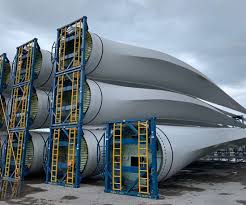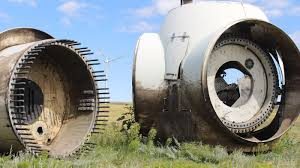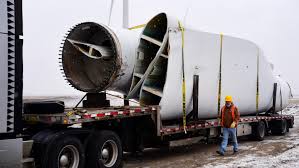
The issue of old wind turbine blades and how to dispose of them is becoming a growing challenge for the wind industry, as well as states.
As we’ve reported recently, the state of Wyoming is considering a ban of disposing the blades in landfills. E & E news reports one company in Iowa has a plan how to recycle the turbine blades and not dispose of them.
Wind turbine blades are piled up outside a former Maytag plant in central Iowa where a company hopes to help recycle them into a wide range of products.
Global Fiberglass Solutions, based in Washington state, has devised a way to slice up retired wind turbine blades into tiny pellets that can then be molded into products such as boards, furniture and packaging. The company already has a factory in Sweetwater, Texas, and it hopes to be producing pellets in Newton, Iowa, about 30 miles east of Des Moines, by the end of the year.
The Iowa plant has been in the works since 2017, and the company has run into challenges since then. Ronald Albrecht, the company’s vice president of business development, said plans were delayed because of asbestos found in the building. The company also realized it needed more space to accommodate its equipment. Modifications are underway.

Albrecht estimates that the company owns a couple thousand blades, divided between the two locations. The huge blades stacked up next to the Maytag facility are a little concerning to Frank Liebl, executive director of the Newton Development Corp.
“There’s turbines all over the place and we’ve got to do something with them,” he said. While he endorses the “wonderful” concept of recycling turbine blades, Liebl said he’s worried about delays in the project.
“I hope it works,” he said. “We’re just hanging in there day by day, week by week.”
Albrecht said the company is focused on marketing, and has been sending out batches of pellets to distributors so they can share them with potential customers. One challenge is aligning production with demand — figuring out how to increase production as demand increases, Albrecht said.
“We want to make sure we can supply them with a couple years’ worth of material,” Albrecht said. “Otherwise, there’s too much risk involved to change their production lines.”

Wind turbine blades are made of inert and stable materials, largely fiberglass, carbon fibers and balsa wood. They take up space but don’t pose a particular environmental threat when placed in landfills. Still, the industry is trying to move toward greater recyclability, said Greg Alvarez, a spokesperson for the American Wind Energy Association. One manufacturer, Vestas, has announced it wants its turbines to be completely recyclable by 2040.
Albrecht declined to identify specific end-users for its pellets but said companies in a number of industries have expressed interest. “Beverage companies want to use it for crates. Flooring companies are coming to us. Railroad ties are another example.”
Industries that use wood and concrete are considering turning to fiberglass pellets instead, he said.
“One thing that’s really helping us out here is a lot of manufacturers are self-mandating to use recycled materials.” One example he cited is the home-furnishings retailer IKEA, which states on its website that by 2030 it will use only recycled or recyclable materials in all of its plastic products.
Global expects to build additional facilities, Albrecht said, because fiberglass waste from wind turbines and other sources is abundant. He said there are an estimated 30,000 blades that are at least 15 years old. Moving the bulky and heavy material is costly. He said he’s talking with people in other states and expects to construct a third plant somewhere in Colorado or Wyoming.
Source: E & E News





